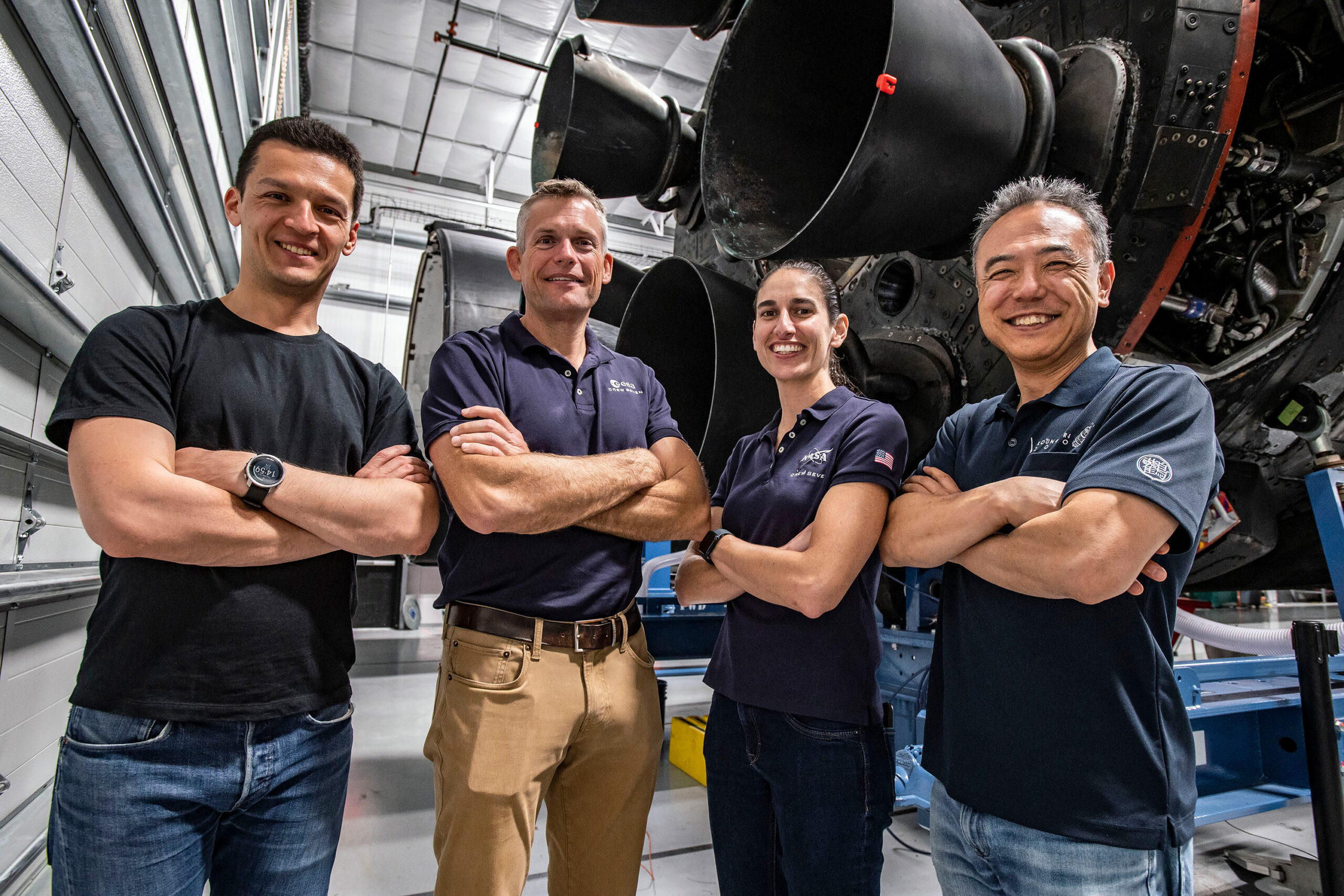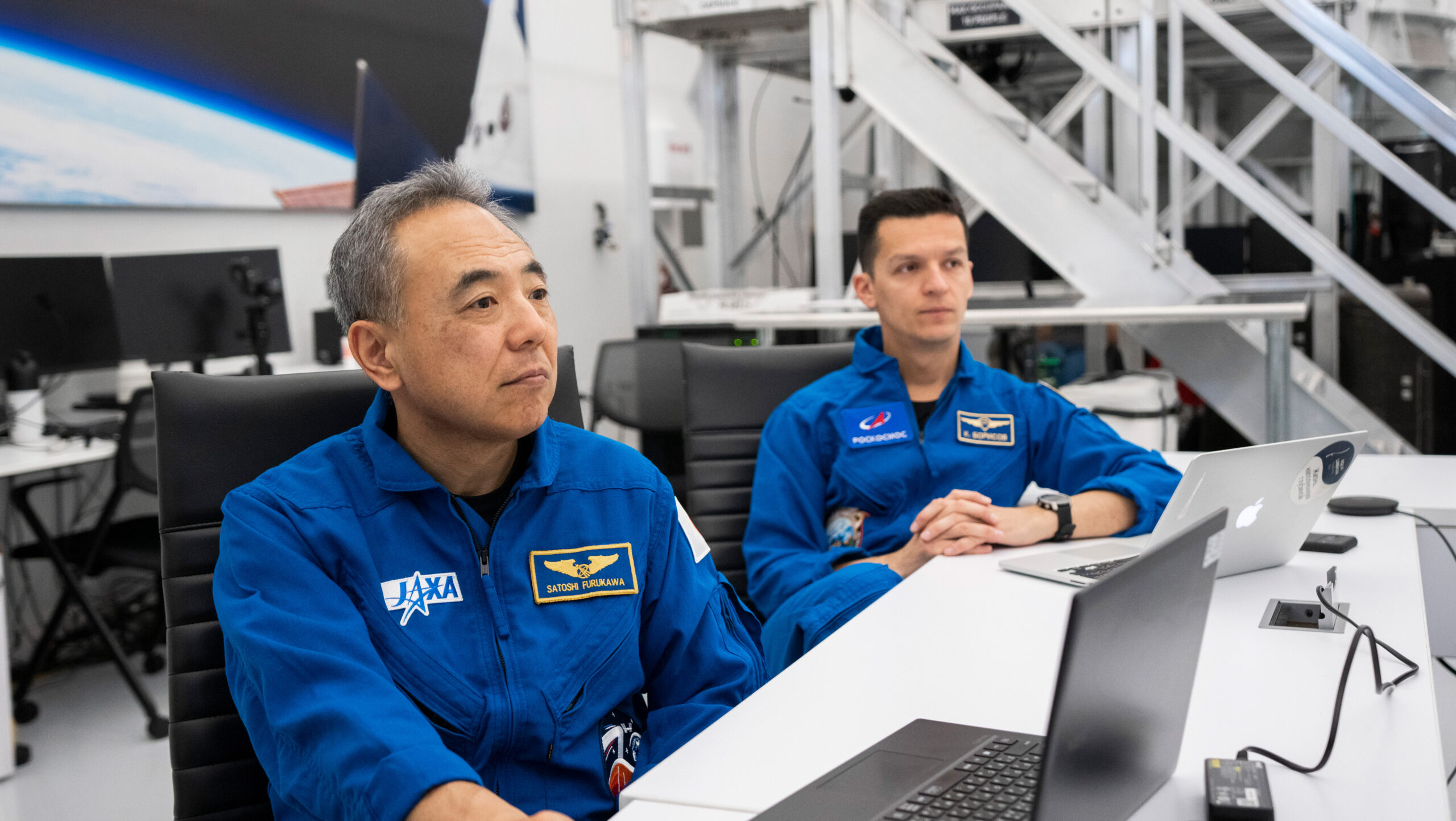
An unflown Falcon 9—the fourth brand-new “single-stick” booster to join SpaceX’s burgeoning fleet so far this year—and a twice-used Crew Dragon are gearing up for liftoff from historic Pad 39A at Florida’s Kennedy Space Center (KSC)no sooner than 7:44 a.m. EDT Tuesday, 15 August, bound for a six-month stay aboard the International Space Station (ISS). Crew-7 Commander Jasmin “Jaws” Moghbeli of NASA will be joined aboard Dragon Endurance by European Space Agency (ESA) astronaut Andreas Mogensen of Denmark, Japan’s Satoshi Furukawa and Russian cosmonaut Konstantin Borisov, marking the first Crew Dragon flight to represent four sovereign nations.

In a little more than three years of Crew Dragon operations, ten crewed missions have flown, all but one of which visited the ISS. Currently on-orbit on her record-setting fourth flight is Dragon Endeavour, which first lifted Demo-2 astronauts Doug Hurley and Bob Behnken to the station on 30 May 2020.
Theirs was the first crewed U.S. space mission in almost nine years, since the retirement of the Space Shuttle fleet. After 63 days in orbit, Hurley and Behnken returned to Earth and completed the first U.S. water landing in more than four decades.

Since then, the Crew Dragon fleet has expanded to four members, with Resilience coming online in November 2020, Endurance in November 2021 and Freedom in April of last year. All three have logged two missions apiece, with newcomer Freedom wrapping up her most recent flight in late May with the Ax-2 research mission on behalf of Houston, Texas-based AxiomSpace, Inc.
Across those three years, Endeavour has totalled more than a year in space—413 cumulative days as of this morning, across her four flights—and with last year’s Ax-1 mission was first to fly an all-private crewed mission to the ISS.

In November 2020, Resilience became the first Crew Dragon to launch with representatives of two sovereign nations(the United States and Japan) and in April 2021 Endeavour did likewise for three nations (the United States, France and Japan). With next month’s launch and spacefarers from the United States, Denmark, Japan and Russia, Crew-7 will become the first to feature as many as four nations.
Other records have fallen like ninepins over the past 38 months. Resilience’s Crew-1 marked the longest single mission by a U.S. crew-carrying spacecraft since the final Skylab flight and Endeavour’s Crew-2 holds America’s current empirical record of 199 days on one mission. Crew-1’s Victor Glover—currently in training for Artemis II, as detailed recently by AmericaSpace’s Alex Longo—also became the first African-American astronaut to embark on a long-duration ISS stay.

In September 2021, Resilience logged the shortest Crew Dragon mission, at less than three days, but also one of the most significant: for Inspiration4, commanded by PayPal and Shift4Payments entrepreneur Jared “Rook” Isaacman, was the first all-civilian crewed orbital flight. Its four-member crew included physician’s assistant Hayley Arceneaux, a bone cancer survivor and the first person to travel into orbit with a prosthesis.
On Crew-7, Dragon Endurance will make her third trek into space, following two prior long-duration ISS missions, totaling more than 333 days. She first launched in November 2021 with the U.S./German Crew-3 quartet, including Tom Marshburn and Kayla Barron, the oldest and youngest long-duration U.S. crew members to board the ISS.

Following their return to Earth in May of last year, Endurance was turned around rapidly for her Crew-5 launch in early October, when she lifted two Americans—including the first woman to command a Crew Dragon—together with a Japanese astronaut and Anna Kikina, the first Russian cosmonaut to fly aboard a Commercial Crew vehicle. Upon their return home last March, Endurance concluded the second mission of her spacefaring career with a cumulative total of 333 days, 12 hours and 40 minutes of flight time and more than 5,300 Earth orbits completed.
Endurance also earned an unusual place in history as the only Crew Dragon so far to have been commanded on each of her missions by a first-time astronaut: Raja Chari on Crew-3, Nicole Mann on Crew-5 and Moghbeli on Crew-7.

Assembly of the Crew-7 quartet got underway in March 2022, when Moghbeli and Mogensen were assigned to the mission; the former set to become only the second woman to command a crew on her first space voyage, the latter the first non-U.S. astronaut to pilot a U.S. spacecraft. Earlier this year, it was also announced that Mogensen will rotate into the command of Expedition 70 aboard the space station from late September, through Crew-7’s targeted return to Earth in February of next year.
Earlier this spring, NASA and the Japan Aerospace Exploration Agency (JAXA) identified veteran ISS resident Satoshi Furukawa as the mission’s third crew member. And last month, Russia’s Konstantin Borisov was identified for Endurance’s fourth seat.

In readiness for next month’s launch, the Crew Dragon is undergoing final preparations and checkout, ahead of integration of the spacecraft’s heat shield and mounting of the pressurized crew module atop the unpressurized “trunk”. Moghbeli’s crew—like all previous Crew Dragons flown so far this year—will launch atop a brand-new Falcon 9 booster, tailnumbered “B1081”. The booster underwent cryogenic “proofing” tests and a static firing of its nine Merlin 1D+ engines at SpaceX’s Rocket Development Facility in McGregor, Texas, just last month.
After launch, B1081 will become the second crew-carrying Falcon 9 core to execute a “land” touchdown on Landing Zone (LZ)-1 at Cape Canaveral Space Force Station, Fla. The rocket’s second stage will propel Moghbeli, Mogensen, Furukawa and Borisov on their onward trek to the space station, where they will be welcomed by the incumbent Expedition 69 crew of Commander Sergei Prokopyev, his Russian crew mates Dmitri Petelin and Andrew Fedyayev, U.S. astronauts Frank Rubio, Steve Bowen and Warren “Woody” Hoburg and Sultan Al-Neyadi of the United Arab Emirates (UAE).

Following a week-long handover, Bowen, Hoburg, Fedyayev and Al-Neyadi will depart the complex aboard Dragon Endeavour in late August, returning home after six months in orbit. On 15 September, Soyuz MS-24 will launch from Russia’s Baikonur Cosmodrome, carrying Russian cosmonauts Oleg Kononenko and Nikolai Chub, flying shoulder-to-shoulder with NASA astronaut Loral O’Hara.
Prokopyev, Petelin and Rubio will return to Earth on 27 September, wrapping up over 370 days in orbit, the longest single increment ever undertaken aboard the ISS. And in doing so, Rubio will eclipse fellow astronaut Mark Vande Hei as holder of the record for the longest single U.S. human spaceflight.

Their departure will formally end Expedition 69 and begin Expedition 70, which will continue under Mogensen’s command until Crew-7 returns to Earth in February 2024. Their increment is expected to see the arrival of up to six uncrewed visiting vehicles—three Russian Progress ships in August, December and February, a Northrop Grumman Corp. Cygnus in December, a SpaceX Cargo Dragon and the first Dream Chaser mini-shuttle, built by Sierra Nevada Corp. (SNC)—and the long-awaited Crew Flight Test (CFT) of Boeing’s CST-100 Starliner, carrying NASA astronauts Barry “Butch” Wilford and Suni Williams for a week-long visit, possibly as soon as October.
And despite the brief stay-time of Wilmore and Williams, Expedition 70 will garner a measure of the unique, in that for almost six months the ISS will boast a long-duration U.S. presence of only two astronauts from a full ISS complement of seven. Significantly, those two—Moghbeli and O’Hara—make Expedition 70 the first ISS increment to have an all-female U.S. crew complement.





